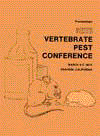Vertebrate Pest Conference: Proceedings

Vertebrate Pest Conference Proceedings: 6th (1974)
Date of this Version
March 1974
Document Type
Article
Abstract
Man with his continual movement and his need to construct has devastated the wilderness. Provided with man's year-round lush vegetation, his sheltered and protected area, wildlife has adapted to urbanization. Urbanized wildlife is not always tolerated by man. Management of vertebrate pests in urban areas is specialized. Toxic baits or hazardous techniques are avoided to prevent exposure to people, pets, and other non-targets. Birds, as woodpeckers, crows, and hawks, which are urbanized wildlife in wooden and other structures of parks, residences, and airports, can be controlled by wire screens, topping trees, or removing their food source. Rodents, as rabbits and ground squirrels, can be controlled by proper placement and safe management of toxic baits. If uncontained, their predators, as snakes, also migrate to urban districts. Other reptiles, as lizards, are also intolerable to some human urbanites. Like migratory skunks disrupting turf in urban areas, control of insects will reduce lizard and skunk populations. By live trapping raccoons and opossums and moving them away from urbanization, undue harm can also be avoided to these occasional visitors . Humane control methods compatible with all life --the vertebrate pest, man and his pets, and non-targets, should be considered especially when dealing with urbanized wildlife.

